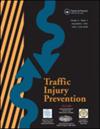Driving under the influence: An analysis of second-time offenders and intervention success, Turkey sample
IF 1.6
3区 工程技术
Q3 PUBLIC, ENVIRONMENTAL & OCCUPATIONAL HEALTH
引用次数: 0
Abstract
Objectives
Driving under the influence (DUI) of alcohol is a major public health issue that results in significant mortality, morbidity, and economic costs. Despite various penalties and interventions, DUI remains prevalent. This study examines the demographic characteristics, educational status, and involvement in motor vehicle accidents of second-time DUI offenders, aiming to identify factors influencing the success of educational interventions.
Methods
Between 2018 and 2023, 151 individuals whose driver’s licenses were suspended for a second DUI offense participated in this study. All participants applied to the Adıyaman Provincial Health Directorate, located in the southeast region of Turkey, to regain their licenses. Data were collected from application documents and digital records during and after the educational program, which included identity information, demographic characteristics, reasons for alcohol consumption, license duration, education level, educational success, frequency of alcohol use, and behavior under the influence. Penalties and traffic accidents in the last 5 years were also recorded.
Results
Participants with a high school education and above had a significantly higher success rate in the educational program (P = .03). Those without penalties (P = .001) and those not involved in traffic accidents (P = .006) also showed higher success rates.
Conclusion
Despite its limitations, this study shows that second-time DUI offenders who have previous traffic tickets or accidents are less likely to succeed in educational interventions. These findings suggest the need for tailored training programs, extended durations, and personalized evaluations to improve outcomes for these high-risk groups. Future research should explore prospective studies to confirm these results and guide intervention strategies.
酒后驾车:对二次犯罪者和干预成功率的分析,土耳其样本。
目标:酒后驾车(DUI)是一个重大的公共卫生问题,会导致严重的死亡率、发病率和经济损失。尽管采取了各种处罚和干预措施,酒后驾车现象仍然十分普遍。本研究考察了酒驾二次犯罪者的人口特征、教育状况和参与机动车事故的情况,旨在找出影响教育干预成功的因素:2018 年至 2023 年间,151 名因二次酒驾被吊销驾照的人员参与了本研究。所有参与者都向位于土耳其东南部地区的阿德亚曼省卫生局申请重新获得驾照。研究人员从申请文件和教育计划期间及之后的数字记录中收集了数据,其中包括身份信息、人口统计学特征、饮酒原因、驾照有效期、教育水平、教育成就、饮酒频率和酒后行为。此外,还记录了过去 5 年中的处罚和交通事故:结果:高中及以上学历的参与者在教育计划中的成功率明显更高(P = .03)。没有受过处罚的参与者(P = .001)和没有发生过交通事故的参与者(P = .006)的成功率也更高:尽管存在局限性,但本研究表明,曾被开过交通罚单或发生过交通事故的酒驾二次犯罪者不太可能在教育干预中取得成功。这些研究结果表明,有必要为这些高危人群量身定制培训计划、延长培训时间并进行个性化评估,以提高培训效果。未来的研究应探索前瞻性研究,以确认这些结果并指导干预策略。
本文章由计算机程序翻译,如有差异,请以英文原文为准。
求助全文
约1分钟内获得全文
求助全文
来源期刊

Traffic Injury Prevention
PUBLIC, ENVIRONMENTAL & OCCUPATIONAL HEALTH-
CiteScore
3.60
自引率
10.00%
发文量
137
审稿时长
3 months
期刊介绍:
The purpose of Traffic Injury Prevention is to bridge the disciplines of medicine, engineering, public health and traffic safety in order to foster the science of traffic injury prevention. The archival journal focuses on research, interventions and evaluations within the areas of traffic safety, crash causation, injury prevention and treatment.
General topics within the journal''s scope are driver behavior, road infrastructure, emerging crash avoidance technologies, crash and injury epidemiology, alcohol and drugs, impact injury biomechanics, vehicle crashworthiness, occupant restraints, pedestrian safety, evaluation of interventions, economic consequences and emergency and clinical care with specific application to traffic injury prevention. The journal includes full length papers, review articles, case studies, brief technical notes and commentaries.
 求助内容:
求助内容: 应助结果提醒方式:
应助结果提醒方式:


